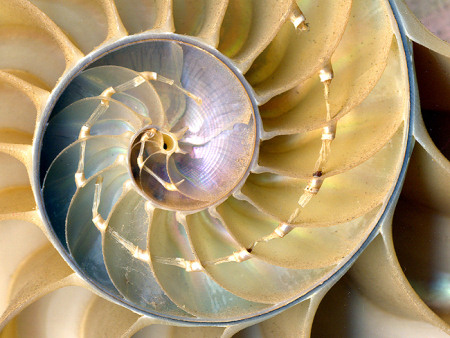Physics in the animal world: nautilus and its "osmotic pump"

Source: youtube
Nautilus (lat. Nautilus) is a genus of cephalopod mollusks, which are referred to as "living minerals". The most common species is Nautilus pompilius. Nautiluses belong to the only modern genus of the nautiloid subclass. The first representatives of the nautiloids appeared in the Cambrian, and its development fell on the Paleozoic. The Nautilides were almost extinct on the border of the Triassic and Jurassic, but still survived to our days, unlike their relatives, the Ammonites. Some species of ancient nautilus reached a size of 3.5 m. Representatives of the largest species of modern nautilus reach a maximum size of 25 cm.
Modern nautilus are found in the Pacific and Indian oceans. In some regions they are numerous, but their distribution is not too wide. Nautilus live at depths of 100-600 meters. These mollusks are constantly moving in the water column, both vertically and horizontally, and osmosis is used to move vertically in the nautilus - changing the concentration of salts in the cavities of their shell
Horizontally, the nautilus move like cephalopod mollusks — by ejecting a jet of water from a funnel. The back of the leg, which all mollusks have, turned into a funnel. The funnel is a conical tube that leads to the mantle cavity. It serves as a "engine" and a wheel. The nautilus horizontally regulate the speed with the help of the frequency of water ejection from the funnel and the change in its diameter. They swim in the sink ahead, but if you need to grab the prey, then turn to the victim "face".
')
Much more interesting is the mechanism for moving the nautilus vertically. Shellfish can easily regulate their buoyancy, becoming lighter or heavier than water, using the force of osmotic pressure . The shell of the mollusk, except for the residential compartment and several old chambers, is filled with a liquid whose composition differs from sea water. In particular, the concentration of salts in this fluid is lower than in seawater. Several chambers are filled with biological gas, which is produced by nautilus in the process of life.
In order to better understand the mechanism of movement of the nautilus, it is worth considering the structure of its shell. In all types of nautilus shells are spiral, strongly curled. The mollusk's body is always located in the last, largest chamber. The remaining chambers work as a hydrostatic system. There are holes in the shell partitions, a thin tube passes through them, which is called a siphon. This tube connects to the back of the nautilus body.

Nautilus shell in section. The siphon is not visible because it consists of soft tissues that are not in the sink in the photo (Source: Wikipedia)
If a nautilus needs to float, it becomes lighter than water due to the pumping of monovalent ions from this liquid through a siphon. These are mainly Na + and Cl-. The concentration of monovalent ions is regulated using a special enzyme, Na-K-ATPase . The hormone is produced and accumulates in the epithelial tissue of the siphon. First, the ions are pumped out of the chamber fluid, after which they enter the siphon, and then into the blood. Osmotic pressure occurs, water with a low salt concentration enters the siphon, and then through the kidneys into the environment. In a number of chambers of the mollusk shell, a vacuum is formed, they are filled with gas, the shell becomes lighter, and the nautilus pops up.

The siphon can be seen very well in this photo (source: discoveringfossils.co.uk)
If the nautilus needs to sink, the ions from the blood enter the shell fluid under the action of Na-K-ATPase. Osmotic pressure leads to the fact that the sink collects water, the shell chambers are gradually filled, and the animal along with the sink becomes heavier than water, which allows the nautilus to dive. The maximum depth of immersion is about 700 meters, which corresponds to 70 atmospheres. It is this pressure that the nautilus shell can withstand. Having sunk deeper, the animal will simply die.
Nautilus can adjust its buoyancy so that it is still immobilized in the thickness of the sea water. The center of buoyancy of the nautilus does not coincide with the center of gravity, being several centimeters higher. This allows for the vertical stability of the mollusk. When hovering in the water column, you can see how the nautilus swings with a certain amplitude. This is because the mollusk for breathing takes water into the sink. When exhaling, the jet of water gives a push back, the sink deviates from its original position. When you "inhale" the clam returns to its original position.
Nautilus have another interesting feature - their eyes are devoid of lenses and corneas. The pupil in their eye is a regular opening through which light enters the retina directly. There is no shell of this eye, the pupil and the cavity of the eye are filled with water. Japanese researchers studied the nautilus genome , and found that this mollusk does not have the Six3 / 6 gene. This is the oldest gene that exists in almost all animals, from mollusks to humans. He is responsible for the formation of the lens and cornea. Perhaps the ancestors of the nautilus for any reason lost this gene in the process of evolution. There is also an assumption that the eye of the nautilus is a transitional form between the primitive light-sensitive eye and the complex eye with the lens and cornea.
Source: https://habr.com/ru/post/369547/
All Articles